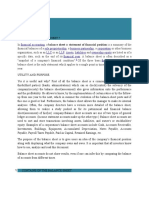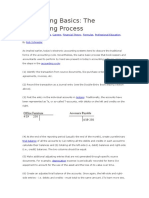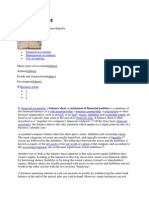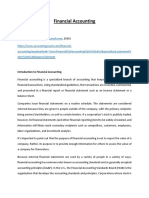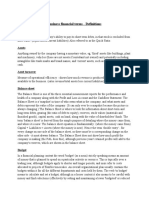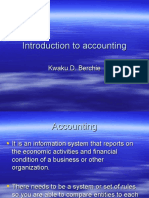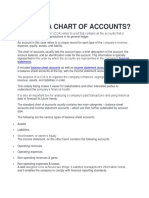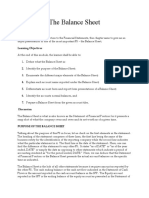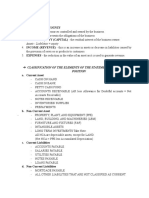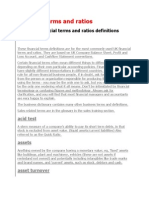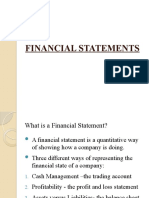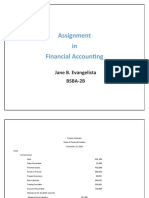Receita KIWIFF
Receita KIWIFF
Uploaded by
ithallothallysdejesuslopesCopyright:
Available Formats
Receita KIWIFF
Receita KIWIFF
Uploaded by
ithallothallysdejesuslopesOriginal Description:
Copyright
Available Formats
Share this document
Did you find this document useful?
Is this content inappropriate?
Copyright:
Available Formats
Receita KIWIFF
Receita KIWIFF
Uploaded by
ithallothallysdejesuslopesCopyright:
Available Formats
Title:
A Crash Course on Understanding Financial Statements
Word Count:
629
Summary:
If you're in business or learning to value a business it's important that you learn
how to understand financial statements. While they may be confusing to glance at,
the information that's important is easy to find.
Keywords:
financial statements, business bookeeping
Article Body:
Financial statements (or financial reports) are a record of a business� financial
flows and levels.
The big four statements are:
1.Balance sheet which describes a company's assets and liabilities.
2.Income statement which describes a company's income and expenses.
3.Statement of Cash Flows which describes how corporate operating, investment, and
financing activities have affected the company's cash position.
4.Statement of Retained Earnings which describes changes to shareholders equity
(for example a payment of dividend).
Because these statements are often complex an extensive set of Notes to the
Financial Statements and management discussion and analysis is usually included.
The notes will typically describe each item on the Balance Sheet and Income
statement in further detail. In many cases the notes are much longer than the
financial statement they are elucidating.
If a company has extraordinary items that affect the balance sheet or the
shareholders equity position it will usually include a Other Comprehensive Income
Statement, which describes the adjustments to made. Examples of Other Comprehensive
Income include revaluation of corporate assets away from their stated cost, as well
as accruals for liabilities.
Income Statement: An income statement, otherwise known as a profit and loss
statement, is a summary of a company�s profit or loss during any one given period
of time, such as a month, three months, or one year. The income statement records
all revenues for a business during this given period, as well as the operating
expenses for the business. It is very important to format an income statement so
that it is appropriate to the business being conducted. Income statements, along
with balance sheets, are the most basic elements required by potential lenders,
such as banks, investors, and vendors. They will use the financial reporting
contained therein to determine credit limits.
Statement of Changes in Financial Position: A statement of changes in financial
position (also referred to as the Cash flow Statement) reports the amount of cash
coming in (cash receipts) and the amount of cash going out (cash payments or
disbursements) during a specified period. Business activities result in either a
net cash inflow (receipts greater than payments) or a net cash outflow (payments
greater than receipts) during a period. The cash flow statement shows the net
increase or decrease in cash during the period and the cash balance at the end of
the period. It explains the causes for the changes in the cash balance. The cash
flow statement covers a span of time.�
Balance Sheet: A balance sheet, in formal bookkeeping and accounting, is a
statement of the book value of a business or other organization or person at a
particular date, often at the end of its "fiscal year," as distinct from an income
statement, also known as a profit and loss account (P&L), which records revenue and
expenses over a specified period of time.
Assets: Any item of economic value owned by an individual or corporation,
especially that which could be converted to cash. Examples are cash, securities,
accounts receivable, inventory, office equipment, real estate, a car, and other
property. On a balance sheet, assets are equal to the sum of liabilities, common
stock, preferred stock, and retained earnings.
From an accounting perspective, assets are divided into the following categories:
current assets (cash and other liquid items), long-term assets (real estate, plant,
equipment), prepaid and deferred assets (expenditures for future costs such as
insurance, rent, interest), and intangible assets (trademarks, patents, copyrights,
goodwill).
Liabilities: A liability is a present obligation of the enterprise arising from
past events, the settlement of which is expected to result in an outflow from the
enterprise of resources embodying economic benefits.
Owner's Equity: Total assets minus total liabilities of an individual or company.
For a company, also called net worth or shareholders' equity or net assets.
You might also like
- ACC 102 Perpetual Inventory SystemDocument21 pagesACC 102 Perpetual Inventory Systemice100% (1)
- Understanding Financial Statements (Review and Analysis of Straub's Book)From EverandUnderstanding Financial Statements (Review and Analysis of Straub's Book)Rating: 5 out of 5 stars5/5 (5)
- Chapter 10 - Accounting Policies, Changes in Accounting Estimates and ErrorsDocument32 pagesChapter 10 - Accounting Policies, Changes in Accounting Estimates and ErrorsPatrick Peñaflor100% (2)
- Referenced Trial BalanceDocument12 pagesReferenced Trial BalanceShohag RaihanNo ratings yet
- Chapter 10Document4 pagesChapter 10Nguyên BùiNo ratings yet
- Financial Accounting Reporting: Time. in Accounting, We Measure Profitability For A Period, Such As A Month or YearDocument2 pagesFinancial Accounting Reporting: Time. in Accounting, We Measure Profitability For A Period, Such As A Month or YearMuneebAhmedNo ratings yet
- Balance SheetDocument4 pagesBalance SheetPFENo ratings yet
- Introduction To Financial AccountingDocument3 pagesIntroduction To Financial AccountingnidayousafzaiNo ratings yet
- Financial ReportDocument3 pagesFinancial Reportlina vyxNo ratings yet
- Accounting IntroductionDocument10 pagesAccounting Introductionomer mazharNo ratings yet
- Financial Performance AnalysisDocument5 pagesFinancial Performance AnalysisKiruthika Sundar100% (1)
- ACC321Document5 pagesACC321Allysa Del MundoNo ratings yet
- Accounting Basics: The Accounting ProcessDocument21 pagesAccounting Basics: The Accounting ProcessZahur AhmedNo ratings yet
- Financial StatementsDocument8 pagesFinancial StatementsbouhaddihayetNo ratings yet
- Financial AnalysisDocument5 pagesFinancial Analysissimmi33No ratings yet
- Financial StatementsDocument6 pagesFinancial StatementsYasir ABNo ratings yet
- Balance Sheet: AccountingDocument5 pagesBalance Sheet: AccountingPrathameshChoudhury100% (1)
- What Are Financial StatementsDocument4 pagesWhat Are Financial StatementsJustin Era ApeloNo ratings yet
- Muzzamil Janjua SAP ID 42618Document9 pagesMuzzamil Janjua SAP ID 42618Muzzamil JanjuaNo ratings yet
- Financial Modelling: Types of Financial ModelsDocument7 pagesFinancial Modelling: Types of Financial ModelsNavyaRaoNo ratings yet
- Chapter 3 HandoutsDocument9 pagesChapter 3 HandoutsHonie Jane D. AmerilaNo ratings yet
- Muzzamil Janjua SAP ID 42618Document9 pagesMuzzamil Janjua SAP ID 42618Muzzamil JanjuaNo ratings yet
- ACC321Document6 pagesACC321Allysa Del MundoNo ratings yet
- DocumentDocument8 pagesDocumentDivyansh SinghNo ratings yet
- MTTM 05 2021Document10 pagesMTTM 05 2021Rajni KumariNo ratings yet
- Statement of Financial PositionDocument11 pagesStatement of Financial Positionshafira100% (1)
- Introduction To Financial AccountingDocument3 pagesIntroduction To Financial AccountingDOTA 2easyNo ratings yet
- REFERENCE READING 1.2 Finance For ManagerDocument5 pagesREFERENCE READING 1.2 Finance For ManagerDeepak MahatoNo ratings yet
- Components of Financial StatementDocument4 pagesComponents of Financial StatementsonuNo ratings yet
- Introduction To AccountingDocument34 pagesIntroduction To AccountingBianca Mhae De LeonNo ratings yet
- 4 Common Types of Financial Statements To Know: 1. What Is A Statmemt of Financial Position (Balance Sheets) ?Document15 pages4 Common Types of Financial Statements To Know: 1. What Is A Statmemt of Financial Position (Balance Sheets) ?Ray Allen Uy100% (1)
- Financial Analysis: Submitted byDocument18 pagesFinancial Analysis: Submitted bybernie john bernabeNo ratings yet
- Final Accounts LessonDocument12 pagesFinal Accounts LessonSiham KhayetNo ratings yet
- Business Financial Terms - Definitions: Acid TestDocument11 pagesBusiness Financial Terms - Definitions: Acid Testaishwary rana100% (1)
- 2 Introduction To Financial AccountingDocument61 pages2 Introduction To Financial AccountingGabriel Alva AnkrahNo ratings yet
- What Is A Chart of Accounts?: Financial Statements Balance Sheet Accounts Income Statement AccountsDocument12 pagesWhat Is A Chart of Accounts?: Financial Statements Balance Sheet Accounts Income Statement AccountsRoanNo ratings yet
- A Balance SheetDocument3 pagesA Balance SheetKarthik ThotaNo ratings yet
- Chapter 2 Financing EnterpriseDocument9 pagesChapter 2 Financing EnterpriseMaheen AtharNo ratings yet
- The Balance SheetDocument7 pagesThe Balance Sheetsevirous valeriaNo ratings yet
- Acn 301 MidDocument6 pagesAcn 301 Midkingkhan009No ratings yet
- Definition of AccountingDocument3 pagesDefinition of AccountingtpequitNo ratings yet
- The Four Financial StatementsDocument3 pagesThe Four Financial Statementsmuhammadtaimoorkhan100% (3)
- Accounting Terminologies FABM 2121Document5 pagesAccounting Terminologies FABM 2121Richard MerkNo ratings yet
- Unit 4Document25 pagesUnit 4venkyNo ratings yet
- Finman CHPT 1Document12 pagesFinman CHPT 1Rosda DhangNo ratings yet
- Entrepreneurship (Handouts)Document2 pagesEntrepreneurship (Handouts)alhafeed073No ratings yet
- Major Financial StatementsDocument3 pagesMajor Financial Statementsmohammad.abrar.yasinNo ratings yet
- Financial StatementsDocument6 pagesFinancial StatementsDionicioHernandez22No ratings yet
- What is CostingDocument14 pagesWhat is Costingkirandahiya243No ratings yet
- Accounting Notes For BbaDocument6 pagesAccounting Notes For BbaadnanNo ratings yet
- Unit 7 Subject BackgroundDocument2 pagesUnit 7 Subject Backgroundsleevaolga6No ratings yet
- FM TermpaoerDocument34 pagesFM TermpaoerFilmona YonasNo ratings yet
- Elements of Financial Statements & The Recognition Criteria For Assets & LiabilitiesDocument13 pagesElements of Financial Statements & The Recognition Criteria For Assets & LiabilitiesdeepshrmNo ratings yet
- ACCTG 1 (Assignment 1)Document2 pagesACCTG 1 (Assignment 1)Janine KateNo ratings yet
- Tesda Competency Reviewer, Deped Updates, L.E.T CoverageDocument8 pagesTesda Competency Reviewer, Deped Updates, L.E.T CoverageSharon Ann Basul100% (1)
- ACC Lorena OrtizDocument6 pagesACC Lorena Ortizkxmberly11No ratings yet
- Fabm 2 and FinanceDocument5 pagesFabm 2 and FinanceLenard TaberdoNo ratings yet
- The First One: The Assessment/ Bookkeeping Exam Will Be Composed of Two PartsDocument8 pagesThe First One: The Assessment/ Bookkeeping Exam Will Be Composed of Two PartsGeorge L PastorNo ratings yet
- Financial TermsDocument50 pagesFinancial TermsAdnan Karim DurraniNo ratings yet
- Balance SheetDocument23 pagesBalance Sheetdeepakpareek143No ratings yet
- Chapter 9 - Financial AnalysisDocument13 pagesChapter 9 - Financial AnalysisNicole Feliz InfanteNo ratings yet
- Introduction To Accounting Gp1 by Professor & Lawyer Puttu Guru PrasadDocument33 pagesIntroduction To Accounting Gp1 by Professor & Lawyer Puttu Guru PrasadPUTTU GURU PRASAD SENGUNTHA MUDALIARNo ratings yet
- MAS Handout - Financial AnalysisDocument8 pagesMAS Handout - Financial AnalysisDivine VictoriaNo ratings yet
- Partnership Operations HandoutDocument5 pagesPartnership Operations HandoutAlyssa Ashley L. Manaid100% (1)
- Balance Sheet Cash Flow Planning Final TechwaveDocument7 pagesBalance Sheet Cash Flow Planning Final TechwaveCatherine WreyfordNo ratings yet
- Lopez, Patrcia-AC213 Guided-Activity 2Document8 pagesLopez, Patrcia-AC213 Guided-Activity 2leonel hipolitoNo ratings yet
- Accounting Basics: For Beginners Dr. P. SreelakshmiDocument19 pagesAccounting Basics: For Beginners Dr. P. SreelakshmiridhiNo ratings yet
- Saq-Aq - VPTDocument7 pagesSaq-Aq - VPTVũ VũNo ratings yet
- Assignment in Financial Accounting: Jane B. Evangelista Bsba-2BDocument4 pagesAssignment in Financial Accounting: Jane B. Evangelista Bsba-2BJane Barcelona Evangelista0% (1)
- Business Finance: JollibeeDocument25 pagesBusiness Finance: JollibeespaghettiNo ratings yet
- CASE STUDY Long-Term Financial PlanningDocument2 pagesCASE STUDY Long-Term Financial PlanningsNo ratings yet
- Formation of Partnership1Document3 pagesFormation of Partnership1itik meowmeowNo ratings yet
- 114 Huma Resource KRUTANICDocument27 pages114 Huma Resource KRUTANICjainsiddharth865No ratings yet
- AKM Annualreport17Document28 pagesAKM Annualreport17The Music TribeNo ratings yet
- MARKETING AND FINANCE (Réparé)Document22 pagesMARKETING AND FINANCE (Réparé)Hervé ObaNo ratings yet
- Finman Formulas Prelims 3Document3 pagesFinman Formulas Prelims 3eiaNo ratings yet
- Lesson 9 - Analysis of Financial StatementDocument26 pagesLesson 9 - Analysis of Financial StatementJannah FrancineNo ratings yet
- BEST LK Per 30 Juni 2022 Dan SP DireksiDocument85 pagesBEST LK Per 30 Juni 2022 Dan SP DireksiThunderMiloNo ratings yet
- 1 ADocument89 pages1 AGaleli PascualNo ratings yet
- AS 6: Depreciation Accounting: IPCC Paper 1: Accounting Chapter 1 Unit 2Document40 pagesAS 6: Depreciation Accounting: IPCC Paper 1: Accounting Chapter 1 Unit 2Jatin PandeNo ratings yet
- Exam 1 BMGT221 ReviewDocument4 pagesExam 1 BMGT221 ReviewseabreezeNo ratings yet
- The Complete Financial Analyst Course - Financial ItemsDocument12 pagesThe Complete Financial Analyst Course - Financial ItemsAdarsh KumarNo ratings yet
- Advanced Accounting (Plant Assets)Document3 pagesAdvanced Accounting (Plant Assets)John JackNo ratings yet
- Lesson 3 - Accounting Equation - For StudentsDocument39 pagesLesson 3 - Accounting Equation - For StudentsJessNo ratings yet
- Short-Term Finance and Planning: Mcgraw-Hill/IrwinDocument25 pagesShort-Term Finance and Planning: Mcgraw-Hill/IrwinMhmood Al-saadNo ratings yet
- Types of Accounts and Rules of Debit & CreditDocument10 pagesTypes of Accounts and Rules of Debit & Creditعرفان لطیف100% (1)
- Manila Cavite Laguna Cebu Cagayan de Oro Davao: FAR Ocampo/Ocampo First Pre-Board Examination AUGUST 3, 2021Document15 pagesManila Cavite Laguna Cebu Cagayan de Oro Davao: FAR Ocampo/Ocampo First Pre-Board Examination AUGUST 3, 2021Bella Choi100% (1)
- FinMan Chap2CDocument21 pagesFinMan Chap2CMandy GimeNo ratings yet
- Analysis and Interpretation of Financial StatementsDocument58 pagesAnalysis and Interpretation of Financial StatementsNiña Gloria Acuin ZaspaNo ratings yet






